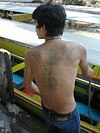|
sak (สัก)
Thai.
‘To tattoo’. In Thai tradition, tattoos usually have a protective
purpose and may have a religious (fig.)
or animist significance, and are thus worn by many a monk (fig.)
or believer. If traditional, they are ritually made by hand using a
‘khem sak’, a heavy metal pin (fig.).
Often they are made by special gifted monks or
Luang Pho, or
specialized religious tattoo artists (fig.).
Commonly seen tattoos are
Hanuman,
a jumping
tiger
(usually tattooed on the chest), the words ‘mother’
and ‘father’ tattooed on the left and right upper arm,
yan
signs and ancient
Khmer
writings (fig.).
Another belief has it that certain tattoos protect against gun
bullets. They are popular amongst soldiers and police stationed in
troubled areas and some popular designs include the yan kao yod (ยันต์เก้ายอด),
literally ‘nine spires with
yan’, a
design on the back of the neck, yan ha thaew (ยันต์ห้าแถว), i.e.
‘five rows of
yan’,
which is typically placed on the back of the right shoulder (fig.), and ten Buddha images,
which are tattooed on the back. It
is alleged that sacred tattoos with supernatural power are best
applied on a Thursday as this is an auspicious day according to
superstition. Like in the West, tattoos are often met with prejudice
or social condemnation, though
these days
they have also become a way of self-expression for many, especially
with youths living in metropolitan areas, and for those who like to
avoid disapproval, have a changing taste or don't like the
permanency of a real tattoo, there are also fake, painted ‘tattoos’
available (fig.).
Religious tattoos are also found in other Buddhist and even Hindu
cultures (fig.).
In
Myanmar,
traditional tattoo needles and design books (fig.) can be found for sale
at many markets nationwide.
回






|

